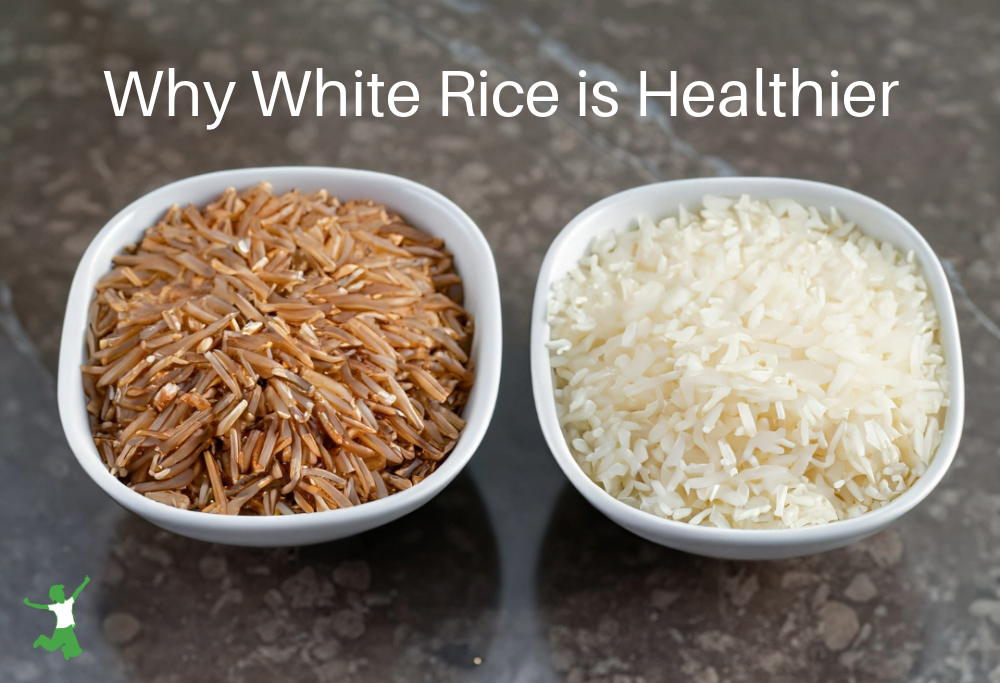The reasons white rice is healthier than brown rice as determined by research as well as which type traditional societies preferred consuming.

My article and video on healthy Chinese food drew some comments from readers who questioned my choice of rice.
Why was I using white rice vs brown? Isn’t brown rice the healthier choice, after all?
Ok, I’ll spill the beans, rice. Here are my reasons …
The truth is, neither my husband nor myself have ever enjoyed brown rice (although we love the nutty flavor and digestibility of wild rice).
Every time we eat brown, it just seems to not sit very well in our stomachs.
Even when it is sprouted or soaked before cooking, it, well, uh, sits like a brick for lack of a better word.
Why Some People Should Eat White Rice
White rice just seems to digest a whole lot better for us. That to me was reason enough to choose it over the brown rice.
We were also advised by an Ayurvedic MD back in the 1990s to stick with white basmati rice. This recommendation clinched the decision.
You are what you digest, after all – not necessarily what you eat!
End of story? Well, not quite.
Rice Fiber in Brown Harms a Compromised Gut
A few years back at the annual Wise Traditions Conference, I became familiar with a compelling book called Fiber Menace.
The author writes extensively about the dangers of a high-fiber diet as it pertains to a menu loaded with whole grains as pushed by the misguided Food Pyramid.
In other words, folks who eat a bowl of All Bran every morning to keep the bathroom visits regular are unknowingly ripping their insides to shreds.
The basic premise of Fiber Menace is that grain fiber plays a leading role in many gut-related ailments including colon cancer.
When I first learned of this information, my preference for white rice over brown rice started to make more sense.
Perhaps the brown rice didn’t digest that well because of all that fiber?
Chalk one up for the white rice.
White Rice Far Lower in Phytic Acid
A second piece of information came from author Ramiel Nagel.
In his book, Cure Tooth Decay, he writes about the devastating effects of phytic acid in the diet. Phytic acid is a very powerful antinutrient and blocker of mineral absorption in the gut.
Mr. Nagel identifies brown rice as very high in phytic acid.
What’s more, soaking brown rice does not reduce phytic acid by much at all!
Polished Rice is the Ancestral Form
Ramiel also maintains that the traditional method for preparing brown rice is never to eat it whole (with only the husk removed).
Rather, ancestral societies pounded brown rice in a mortar and pestle to polish it by removing the outer bran layer. This is the primary source of the phytic acid.
Nagel goes on to point out that experiments have shown that the milled and polished rice that results from this pounding process, has the highest mineral absorption.
In short, mineral absorption from whole brown rice is much less than white polished rice. This is because the phytic acid in the bran which is not reduced much by soaking, greatly interferes with the absorption process.
What About Arsenic?
A big issue with arsenic contamination in rice has emerged in recent years. Some folks have responded by no longer eating rice at all.
This is an overreaction, in my view.
Clean rice is definitely available if you know what to look for.
This article on how to avoid arsenic in rice details what to do. While soaking brown rice barely moves the needle on phytic acid, soaking white rice before cooking removes nearly all the arsenic!
Another option is to parboil white rice before using fresh water for a full cook if you don’t have time to soak.
Is White Rice Better Than Brown?
So it seems that brown rice is not necessarily a healthier choice than milled white rice.
Black or red rice would fall into the same category.
Obviously, whether you choose one or the other is a personal preference, but I hope this information helps you sort through the decision with a bit more clarity.
As for me and my family, we will be sticking with white basmati and jasmine rice (white basmati rice is more nutritious than plain white rice).
I currently buy this brand of rice in 25-pound bags as the most economical and high-quality choice.
Observation clued me in many years ago that brown rice was not something that was sitting well in my stomach or my husband’s.
As the years go by, more research is coming forth to indicate that this decision was the right way to go after all.
Do you eat white rice or brown rice in your home? Why or why not?

References
(1) Fiber Menace
(2) Living with Phytic Acid
More Information
Macrobiotic Diet and Extreme Vitamin D Deficiency
Tiny Teff Grains Deliver Big on Nutrition
How to Make Perfect Yellow Rice (Arroz Amarillo)
Millet: Healthy or Not?
Do Whole Grains Cause Cavities?







Well, you may be a cook, but eating white rice with no nutritional value to speak of, over wholesome brown rice is beyond my comprehension. You body loves brown rice, and to say it sits like a brick in your stomach is also difficult, albeit, your stomach may not be used to healthy foods, in which case, you and your husband are headed for deadly diseases.
No mention of arsenic content. I read somewhere that brown rice contains a lot less arsenic than white rice.
Sarah,
Have you read
Phytic Acid:
A Visual Summary Of The Research On Home Kitchen
Remedies For Phytic Acid by Amanda Rose?
She states, “However, there is some evidence that adding
calcium to the soaking grains inhibits phytic acid reduction (Hallberg et al.,
1991). In our kitchen, we soak our grains in plain warm water.”
Have you heard of this?
Macrobiotics teaches chewing 100 times before swallowing. This predigests the brown rice and there are no digestive problems and you absorb all the nutrients. They also offer fermented brown rice in miso, etc. Very digestible, and all nutrients intact, sugar gone.
We eat white Jasmine rice from the Commissary. When I tried to serve the brown rice to my young children, they were not able to digest it and the end result was ugly. My son has autism so I though his guts were just able to process the amount of fiber. I stopped using it. We use rice quite a bit but I’m always trying to serve it with lots of good butter or coconut oil to slow down the carb digestion.
We eat both. But I prefer white rice since it’s easier to find white rice here in our local market compared to the brown rice. I’ve always thought that brown rice is healthier to eat. Thanks for this article Sarah.
What is your take on Brown Rice Flour?
Hi Sarah and I see this is still a hot topic and yet people even in our own WAPF still don’t know about this. At our local chapter just last Sunday, our leader mentioned to me that she finally posted this blog in her newsletter. Some people overheard her and you should have seen the jaws drop! “What? White Rice Better Than Brown??” and couldn’t believe it, nor did one woman want to change. I hope Sally comes out soon and corrects this or at least comments on it, because all of her recipes in NT call for brown rice. Thanks again Sarah!
i eat and love white rice but since i was diagnosed with diabetes, my mother insists that i eat brown rice, which, according to studies and articles i have read, is much healthier and better for diabetics like me. as you have mentioned in your article, i find brown rice not my “type” of food to ingest besides not that too tasty, therefore, does not satisfy my hunger. i am glad that i have read your article about this. now, i can eat my white rice without guilt. thanks. 🙂
my husband would be very glad to read this article. we’ve tried brown rice before, but like you, it just didn’t sit well in the stomach. also, it doesn’t go well with other food.
as for white rice, i use either jasmine or basmati. i used to get the california grown long grain white rice, but there’s an odd smell to it when you cook it. so, i decided that even if it’s expensive, i’m going to get jasmine rice, which has a very nice aroma. basmati i came across because we love indian food, and basmati rice seems to be the indian choice. i prefer basmati over jasmine because the latter is a little bit starchy, and the former is a bit dry. when i cook garlic fried rice, basmati is a better choice.